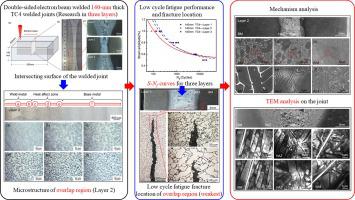当前位置:
X-MOL 学术
›
Int. J. Fatigue
›
论文详情
Our official English website, www.x-mol.net, welcomes your
feedback! (Note: you will need to create a separate account there.)
Analysis of heterogeneity of fatigue properties of double-sided electron beam welded 140-mm thick TC4 titanium alloy joints
International Journal of Fatigue ( IF 5.7 ) Pub Date : 2021-01-01 , DOI: 10.1016/j.ijfatigue.2020.105942 Jian Long , Lin-Jie Zhang , Liang-Liang Zhang , Jie Ning , Ming-Xiang Zhuang , Jian-Xun Zhang , Suck-Joo Na
International Journal of Fatigue ( IF 5.7 ) Pub Date : 2021-01-01 , DOI: 10.1016/j.ijfatigue.2020.105942 Jian Long , Lin-Jie Zhang , Liang-Liang Zhang , Jie Ning , Ming-Xiang Zhuang , Jian-Xun Zhang , Suck-Joo Na

|
Abstract The double-sided electron beam welding (EBW) technique has a prominent advantage that the maximum thickness of the processable plates increases to about twice as much as for single-sided welding. However, there is no in-depth analysis of fatigue properties of the double-sided electron beam welded thick joints with unequal weld penetrations on both sides, especially in the region where two weld seams overlap each other. This research studied low-cycle fatigue properties of the materials in different zones in the thickness direction of a double-sided electron beam welded joint of TC4 titanium alloys with thickness of 140 mm, in which the weld seam on the upper and lower surfaces are about 95 mm and 55 mm in depth respectively. Moreover, S-N curves of the materials in different zones in the thickness direction were obtained. The results showed that low-cycle fatigue properties of the materials in the overlap region (at about 90 mm from the upper surface) of the two weld seams in the double-sided electron beam welded joint were obviously inferior to those in the other zones. By utilizing a high-resolution scanning electron microscope (SEM), the materials in different zones in the thickness direction of the joint were observed. Based on this, it was found that there were more second-phase precipitates in the overlap of the two weld seams compared with the other zones. The microhardness of the overlap region of the two weld seams was found to be higher than those of base metal (BM) and the other zones of the weld seam. Mechanical properties near the overlap region of the two weld seams in the thickness direction of the joint presented most significant heterogeneity, which was one of the important reasons for the weakening of overall mechanical properties of the joint. The research results are of significance for the design and application of a welded structure of titanium alloys with a large thickness in the fields, such as aviation and ships.
中文翻译:

双面电子束焊接140mm厚TC4钛合金接头疲劳性能不均匀性分析
摘要 双面电子束焊接(EBW)技术的突出优点是可加工板材的最大厚度增加到单面焊接的两倍左右。然而,对于两侧焊缝熔深不等的双面电子束焊接厚接头的疲劳性能没有深入分析,特别是在两条焊缝相互重叠的区域。本研究研究了厚度为 140 mm 的 TC4 钛合金双面电子束焊接接头厚度方向不同区域材料的低周疲劳性能,其中上下表面焊缝约为深度分别为 95 毫米和 55 毫米。此外,还得到了材料在厚度方向不同区域的SN曲线。结果表明,双面电子束焊接接头两个焊缝搭接区域(距上表面约90mm处)材料的低周疲劳性能明显低于其他区域。利用高分辨率扫描电子显微镜(SEM)对接头厚度方向不同区域的材料进行了观察。基于此发现,与其他区域相比,两个焊缝重叠处的第二相析出物更多。发现两个焊缝重叠区域的显微硬度高于母材 (BM) 和焊缝其他区域的显微硬度。接头厚度方向两条焊缝搭接区域附近的力学性能表现出最显着的不均匀性,这是接头整体力学性能减弱的重要原因之一。研究成果对大厚度钛合金焊接结构在航空、船舶等领域的设计和应用具有重要意义。
更新日期:2021-01-01
中文翻译:

双面电子束焊接140mm厚TC4钛合金接头疲劳性能不均匀性分析
摘要 双面电子束焊接(EBW)技术的突出优点是可加工板材的最大厚度增加到单面焊接的两倍左右。然而,对于两侧焊缝熔深不等的双面电子束焊接厚接头的疲劳性能没有深入分析,特别是在两条焊缝相互重叠的区域。本研究研究了厚度为 140 mm 的 TC4 钛合金双面电子束焊接接头厚度方向不同区域材料的低周疲劳性能,其中上下表面焊缝约为深度分别为 95 毫米和 55 毫米。此外,还得到了材料在厚度方向不同区域的SN曲线。结果表明,双面电子束焊接接头两个焊缝搭接区域(距上表面约90mm处)材料的低周疲劳性能明显低于其他区域。利用高分辨率扫描电子显微镜(SEM)对接头厚度方向不同区域的材料进行了观察。基于此发现,与其他区域相比,两个焊缝重叠处的第二相析出物更多。发现两个焊缝重叠区域的显微硬度高于母材 (BM) 和焊缝其他区域的显微硬度。接头厚度方向两条焊缝搭接区域附近的力学性能表现出最显着的不均匀性,这是接头整体力学性能减弱的重要原因之一。研究成果对大厚度钛合金焊接结构在航空、船舶等领域的设计和应用具有重要意义。











































 京公网安备 11010802027423号
京公网安备 11010802027423号